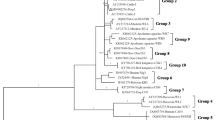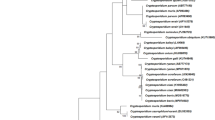Abstract
Microsporidia is a group of spore-forming microorganisms with zoonotic potential. This study aimed to compare intestinal microsporidia infections in cat owners and non-pet owners. In total, 210 fecal samples were collected from indoor cats, cat owners, and non-pet owners. DNA extraction was performed and the small subunit ribosomal RNA (SSU rRNA) gene was amplified. To characterize the genotypes, the internal transcribed spacer (ITS) fragment was amplified and sequenced. The phylogenetic trees were drawn to evaluate the relationship among Enterocytozoon bieneusi isolates. Two (2.9%) and one (1.4%) fecal samples from cat owners and one (1.4%) and two (2.9%) fecal samples from non-pet owners were positive for E. bieneusi and Encephalitozoon intestinalis, respectively. E. bieneusi was detected in two cat samples (2.9%). Same infection was not seen between infected cats and their owners. There was no significant difference between the prevalence rate of microsporidia among the cat owners and non-pet owners. Indeed, the genotypes L and type IV were seen in cats, while the genotype D was only detected in human. In this study, E. bieneusi and E. intestinalis were more prevalent among the cat owners and non-pet owners, respectively. Indeed, the higher prevalence of E. bieneusi in cats and their owners might be resulted from the worldwide distribution of this species.





Similar content being viewed by others
Availability of data and materials
The data associated with this manuscript are included in the article.
Abbreviations
- SSU:
-
small subunit
- rRNA:
-
ribosomal RNA
- ITS:
-
internal transcribed spacer
- TEM:
-
transmission electron microscopy
- IFA:
-
immunofluorescence assays
References
Abe N, Kimata I, Iseki M (2009) Molecular evidence of Enterocytozoon bieneusi in Japan. J Vet Med Sci 71(2):217–219. https://doi.org/10.1292/jvms.71.217
Agholi M, Hatam GR, Motazedian MH (2013) HIV/AIDS-associated opportunistic protozoal diarrhea. AIDS Res Human Retrovirus 29(1):35–41. https://doi.org/10.1089/aid.2012.0119
Al-Herrawy AZ, Gad MA (2016) Microsporidial spores in fecal samples of some domesticated animals living in Giza, Egypt. Iran J Parasitol 11(2):195–203
Andersen LA et al (2018) Prevalence of enteropathogens in cats with and without diarrhea in four different management models for unowned cats in the Southeast United States. Vet J 236:49–55. https://doi.org/10.1016/j.tvjl.2018.04.008
Arasaradnam RP, Brown S, Forbes A, Fox MR, Hungin P, Kelman L, Major G, O’Connor M, Sanders DS, Sinha R, Smith SC, Thomas P, Walters JRF (2018) Guidelines for the investigation of chronic diarrhoea in adults: British Society of Gastroenterology, 3rd edition. Gut 67(8):1380–1399. https://doi.org/10.1136/gutjnl-2017-315909
Askari Z, Mirjalali H, Mohebali M, Zarei Z, Shojaei S, Rezaeian T, Rezaeian M (2015) Molecular detection and identification of zoonotic microsporidia spore in fecal samples of some animals with close-contact to human. Iran J Parasitol 10(3):381–388
Dashti A, Santín M, Cano L, de Lucio A, Bailo B, de Mingo MH, Köster PC, Fernández-Basterra JA, Aramburu-Aguirre J, López-Molina N, Fernández-Crespo JC, Calero-Bernal R, Carmena D (2019) Occurrence and genetic diversity of Enterocytozoon bieneusi (Microsporidia) in owned and sheltered dogs and cats in Northern Spain. Parasitol Res 118(10):2979–2987. https://doi.org/10.1007/s00436-019-06428-1
Delrobaei M, Jamshidi S, Shayan P, Ebrahimzade E, Ashrafi Tamai I, Rezaeian M, Mirjalali H (2019) Molecular detection and genotyping of intestinal microsporidia from stray dogs in Iran. Iran J Parasitol 14(1):159–166
Dengjel B, Zahler M, Hermanns W, Heinritzi K, Spillmann T, Thomschke A, Loscher T, Gothe R, Rinder H (2001) Zoonotic potential of Enterocytozoon bieneusi. J Clin Microbiol 39(12):4495–4499. https://doi.org/10.1128/JCM.39.12.4495-4499.2001
Didier ES, Weiss LM (2006) Microsporidiosis: current status. Curr Opin Infect Dis 19(5):485–492. https://doi.org/10.1097/01.qco.0000244055.46382.23
Fiuza V, Lopes CWG, Cosendey RIJ, de Oliveira FCR, Fayer R, Santin M (2016) Zoonotic Enterocytozoon bieneusi genotypes found in Brazilian sheep. Res Vet Sci 107:196–201. https://doi.org/10.1016/j.rvsc.2016.06.006
Franzen C (2008) Microsporidia: a review of 150 years of research. Open Parasitol J 2(1):1–34. https://doi.org/10.2174/1874421400802010001
Galvan-Diaz AL et al (2014) Microsporidia detection and genotyping study of human pathogenic E. bieneusi in animals from Spain. PLoS One 9(3):e92289. https://doi.org/10.1371/journal.pone.0092289
Ghoyounchi R, Ahmadpour E, Spotin A, Mahami-Oskouei M, Rezamand A, Aminisani N, Ghojazadeh M, Berahmat R, Mikaeili-Galeh T (2017) Microsporidiosis in Iran: a systematic review and meta-analysis. Asian Pac J Trop Med 10(4):341–350. https://doi.org/10.1016/j.apjtm.2017.03.017
Jamshidi S, Tabrizi AS, Bahrami M, Momtaz H (2012) Microsporidia in household dogs and cats in Iran; a zoonotic concern. Vet Parasitol 185(2–4):121–123. https://doi.org/10.1016/j.vetpar.2011.10.002
Javanmard E, Mirjalali H, Niyyati M, Jalilzadeh E, Seyed Tabaei SJ, Asadzadeh Aghdaei H, Nazemalhosseini-Mojarad E, Zali MR (2018) Molecular and phylogenetic evidences of dispersion of human-infecting microsporidia to vegetable farms via irrigation with treated wastewater: one-year follow up. Int J Hyg Environ Health 221(4):642–651. https://doi.org/10.1016/j.ijheh.2018.03.007
Javanmard E, Nemati S, Sharifdini M, Rostami A, Mirjalali H, Zali MR (2020) The first report and molecular analysis of Enterocytozoon bieneusi from Raccoon (Procyon lotor) in North of Iran. J Eukaryot Microbiol. https://doi.org/10.1111/jeu.12786
Karim MR, Dong H, Yu F, Jian F, Zhang L, Wang R, Zhang S, Rume FI, Ning C, Xiao L (2014) Genetic diversity in Enterocytozoon bieneusi isolates from dogs and cats in China: host specificity and public health implications. J Clin Microbiol 52(9):3297–3302. https://doi.org/10.1128/JCM.01352-14
Karimi K et al (2020) Molecular epidemiology of Enterocytozoon bieneusi and Encephalitozoon sp., among immunocompromised and immunocompetent subjects in Iran. Microb Pathog 141:103988. https://doi.org/10.1016/j.micpath.2020.103988
Kvac M et al (2017) Stray cats are more frequently infected with zoonotic protists than pet cats. Folia Parasitol (Praha) 64. https://doi.org/10.14411/fp.2017.034
Li W, Li Y, Song M, Lu Y, Yang J, Tao W, Jiang Y, Wan Q, Zhang S, Xiao L (2015) Prevalence and genetic characteristics of Cryptosporidium, Enterocytozoon bieneusi and Giardia duodenalis in cats and dogs in Heilongjiang province, China. Vet Parasitol 208(3–4):125–134. https://doi.org/10.1016/j.vetpar.2015.01.014
Li WC, Qin J, Wang K, Gu YF (2018) Genotypes of Enterocytozoon bieneusi in dogs and cats in eastern China. Iran J Parasitol 13(3):457–465
Li D, Zheng S, Zhou C, Karim MR, Wang L, Wang H, Yu F, Li J, Wang W, Wang Y, Zhang S, Jian F, Wang R, Ning C, Zhang L (2019a) Multilocus typing of Enterocytozoon bieneusi in pig reveals the high prevalence, zoonotic potential, host adaptation and geographical segregation in China. J Eukaryot Microbiol 66:707–718. https://doi.org/10.1111/jeu.12715
Li W, Feng Y, Santin M (2019b) Host specificity of Enterocytozoon bieneusi and public health implications. Trends Parasitol 35(6):436–451. https://doi.org/10.1016/j.pt.2019.04.004
Li WC, Wang K, Gu YF (2019c) Detection and genotyping study of Enterocytozoon bieneusi in sheep and goats in east-central China. Acta Parasitol 64(1):44–50. https://doi.org/10.2478/s11686-018-00006-8
Lobo ML et al (2003) Microsporidia detection in stools from pets and animals from the zoo in Portugal: a preliminary study. J Eukaryot Microbiol 50(Suppl):581–582. https://doi.org/10.1111/j.1550-7408.2003.tb00638.x
Ma JG, Zhang NZ, Hou JL, Zou Y, Hu GX, Zhu XQ, Zhou DH (2017) Detection of Enterocytozoon bieneusi in white yaks in Gansu province, China. Biomed Res Int 2017:5790181–5790184. https://doi.org/10.1155/2017/5790181
Mathis A, Breitenmoser AC, Deplazes P (1999) Detection of new Enterocytozoon genotypes in faecal samples of farm dogs and a cat. Parasite 6(2):189–193. https://doi.org/10.1051/parasite/1999062189
Matos O, Lobo ML, Xiao L (2012) Epidemiology of Enterocytozoon bieneusi infection in humans. J Parasitol Res 2012:981424–981419. https://doi.org/10.1155/2012/981424
Mirjalali H, Mohebali M, Mirhendi H, Gholami R, Keshavarz H, Meamar AR, Rezaeian M (2014) Emerging intestinal microsporidia infection in HIV(+)/AIDS patients in Iran: microscopic and molecular detection. Iran J Parasitol 9(2):149–154
Mirjalali H, Mirhendi H, Meamar AR, Mohebali M, Askari Z, Mirsamadi ES, Rezaeian M (2015) Genotyping and molecular analysis of Enterocytozoon bieneusi isolated from immunocompromised patients in Iran. Infect Genet Evol 36:244–249. https://doi.org/10.1016/j.meegid.2015.09.022
Mori H, Mahittikorn A, Thammasonthijarern N, Chaisiri K, Rojekittikhun W, Sukthana Y (2013) Presence of zoonotic Enterocytozoon bieneusi in cats in a temple in central Thailand. Vet Parasitol 197(3–4):696–701. https://doi.org/10.1016/j.vetpar.2013.07.025
Nooshadokht M et al (2017) Intestinal microsporidiosis in Iran: infection in immune-compromised and immunocompetent patients. Curr Med Mycol 3(1):30–36. https://doi.org/10.18869/acadpub.cmm.3.1.30
Pekmezci D, Pekmezci GZ, Yildirim A, Duzlu O, Inci A (2019) Molecular detection of zoonotic microsporidia in domestic cats in Turkey: a preliminary study. Acta Parasitol 64(1):13–18. https://doi.org/10.2478/s11686-018-00003-x
Piekarska J, Kicia M, Wesołowska M, Kopacz Ż, Gorczykowski M, Szczepankiewicz B, Kváč M, Sak B (2017) Zoonotic microsporidia in dogs and cats in Poland. Vet Parasitol 246:108–111. https://doi.org/10.1016/j.vetpar.2017.09.011
Pirestani M, Sadraei J, Forouzandeh M (2013) Molecular characterization and genotyping of human related microsporidia in free-ranging and captive pigeons of Tehran, Iran. Infect Genet Evol 20:495–499
Prado JBF, Ramos C, Fiuza V, Terra VJB (2019) Occurrence of zoonotic Enterocytozoon bieneusi in cats in Brazil. Rev Bras Parasitol Vet 28(1):80–90. https://doi.org/10.1590/S1984-296120180096
Ryan NJ, Sutherland G, Coughlan K, Globan M, Doultree J, Marshall J, Baird RW, Pedersen J, Dwyer B (1993) A new trichrome-blue stain for detection of microsporidial species in urine, stool, and nasopharyngeal specimens. J Clin Microbiol 31(12):3264–3269
Sak B, Brady D, Pelikanova M, Kvetonova D, Rost M, Kostka M, Tolarova V, Huzova Z, Kvac M (2011) Unapparent microsporidial infection among immunocompetent humans in the Czech Republic. J Clin Microbiol 49(3):1064–1070. https://doi.org/10.1128/jcm.01147-10
Santin M, Fayer R (2011) Microsporidiosis: Enterocytozoon bieneusi in domesticated and wild animals. Res Vet Sci 90(3):363–371. https://doi.org/10.1016/j.rvsc.2010.07.014
Santin M, Trout JM, Vecino JA, Dubey JP, Fayer R (2006) Cryptosporidium, Giardia and Enterocytozoon bieneusi in cats from Bogota (Colombia) and genotyping of isolates. Vet Parasitol 141(3–4):334–339. https://doi.org/10.1016/j.vetpar.2006.06.004
Santin M, Cortes Vecino JA, Fayer R (2008) Enterocytozoon bieneusi genotypes in dogs in Bogota, Colombia. Am J Trop Med Hyg 79(2):215–217
Stentiford GD, Feist SW, Stone DM, Bateman KS, Dunn AM (2013) Microsporidia: diverse, dynamic, and emergent pathogens in aquatic systems. Trends Parasitol 29(11):567–578. https://doi.org/10.1016/j.pt.2013.08.005
Stentiford GD, Becnel JJ, Weiss LM, Keeling PJ, Didier ES, Williams BAP, Bjornson S, Kent ML, Freeman MA, Brown MJF, Troemel ER, Roesel K, Sokolova Y, Snowden KF, Solter L (2016) Microsporidia - emergent pathogens in the global food chain. Trends Parasitol 32(4):336–348. https://doi.org/10.1016/j.pt.2015.12.004
Tabatabaie F, Abrehdari Tafreshi Z, Shahmohammad N, Pirestani M (2015) Molecular detection of microsporidiosis in various samples of Iranian immunocompromised patients. J Parasit Dis 39(4):634–638. https://doi.org/10.1007/s12639-014-0432-8
Tavalla M, Mardani-Kateki M, Abdizadeh R, Soltani S, Saki J (2018) Molecular diagnosis of potentially human pathogenic Enterocytozoon bieneusi and Encephalitozoon species in exotic birds in Southwestern Iran. J Infect Public Health 11(2):192–196. https://doi.org/10.1016/j.jiph.2017.07.028
Thellier M, Breton J (2008) Enterocytozoon bieneusi in human and animals, focus on laboratory identification and molecular epidemiology. Parasite 15(3):349–358. https://doi.org/10.1051/parasite/2008153349
Valencakova A, Danisova O (2019) Molecular characterization of new genotypes Enterocytozoon bieneusi in Slovakia. Acta Trop 191:217–220. https://doi.org/10.1016/j.actatropica.2018.12.031
Velasquez JN et al (2012) First case report of infection caused by Encephalitozoon intestinalis in a domestic cat and a patient with AIDS. Vet Parasitol 190(3–4):583–586. https://doi.org/10.1016/j.vetpar.2012.06.034
Weiss LM (2001) Microsporidia: emerging pathogenic protists. Acta Trop 78(2):89–102
Xu H et al (2016) Genotypes of Cryptosporidium spp., Enterocytozoon bieneusi and Giardia duodenalis in dogs and cats in Shanghai, China. Parasit Vectors 9:121. https://doi.org/10.1186/s13071-016-1409-5
Zhang Y, Koehler AV, Wang T, Cunliffe D, Gasser RB (2019) Enterocytozoon bieneusi genotypes in cats and dogs in Victoria, Australia. BMC Microbiol 19(1):183. https://doi.org/10.1186/s12866-019-1563-y
Acknowledgments
The authors wish to thank Small Animal Teaching Hospital staff of the Faculty of Veterinary Medicine, University of Tehran, Tehran, Iran.
Funding
This study was funded by the University of Tehran, Faculty of Veterinary Medicine.
Author information
Authors and Affiliations
Contributions
SMV, SJ, and SB presented the idea of the study and designed the study. SMV performed the sampling. SMV, IAT, EJ, and HM were in charge of the laboratory analyses. SB performed the statistical analyses. SMV and HM performed BLAST and phylogenetic analyses. SMV, IAT, SJ, and PS drafted the manuscript. All authors read and approved the final manuscript.
Corresponding authors
Ethics declarations
Informed consent
Informed consent was obtained from all participating cat owners and non-pet owners.
Conflict of interest
The authors declare that they have no conflict of interest.
Consent for publication
All authors of this manuscript declare that we have seen and approved the submitted version of this manuscript.
Additional information
Section Editor: Nawal Hijjawi
Publisher’s note
Springer Nature remains neutral with regard to jurisdictional claims in published maps and institutional affiliations.
Rights and permissions
About this article
Cite this article
Vahedi, S.M., Jamshidi, S., Shayan, P. et al. Intestinal microsporidia infection among cat owners and non-pet owners in Iran: a case-control study. Parasitol Res 119, 1903–1913 (2020). https://doi.org/10.1007/s00436-020-06690-8
Received:
Accepted:
Published:
Issue Date:
DOI: https://doi.org/10.1007/s00436-020-06690-8




